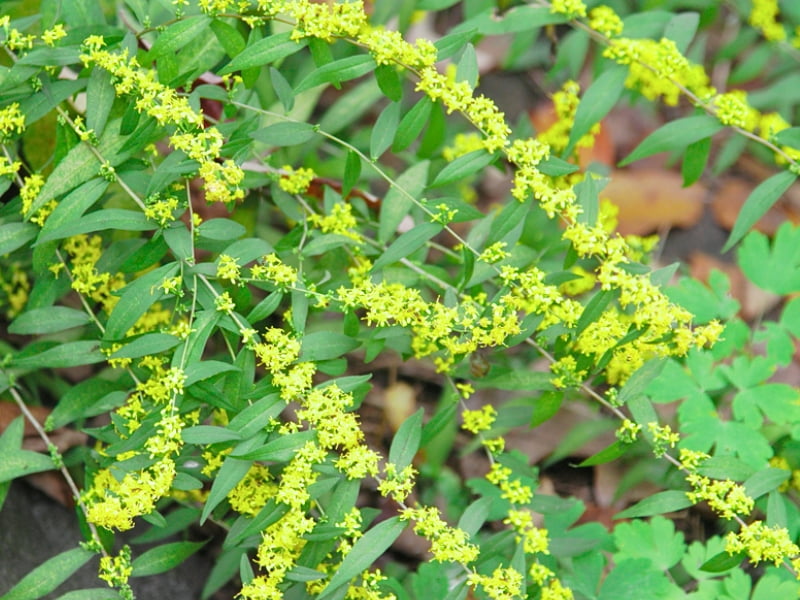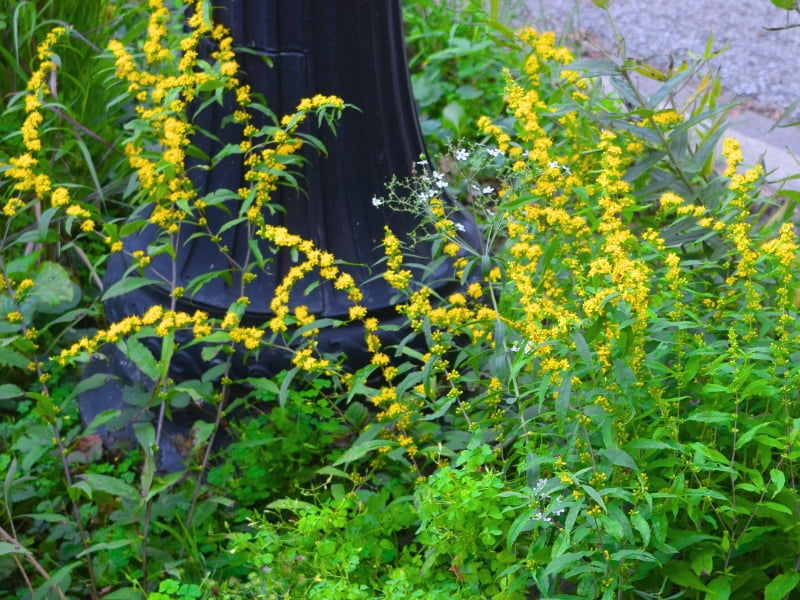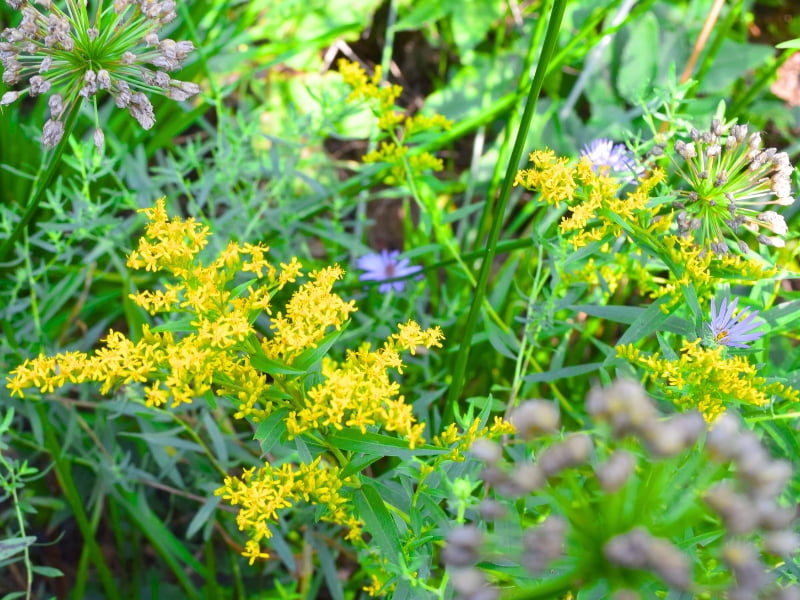Goldenrod, also commonly known as Solidago, Aaron’s Rod, or Woundwort, is a genus of vibrant, late-summer blooming plants belonging to the Asteraceae family. These cheerful perennials, often found in meadows and along roadsides, are much more than just pretty wildflowers.
This article will delve into the many facets of Solidago, from its medicinal properties and use in gardens to dispelling common misconceptions, like its role in allergies. Keep reading to discover the full potential of Goldenrod (Solidago), including its varieties and medicinal uses. Gardencenterpoint.com believes you’ll be surprised by what you learn.

What is Goldenrod? Identifying This Versatile Plant
Goldenrod (Solidago spp.) encompasses a large genus of flowering plants, with over 100 different species, most of which are native to North America. These plants are characterized by their bright yellow flower clusters, which typically bloom in late summer and fall, providing a vital source of nectar and pollen for pollinators like bees and butterflies.
| Common Name | Goldenrod, Aaron’s Rod, Woundwort |
| Botanical Name | Solidago spp. |
| Family | Asteraceae (Aster family) |
| Genus | Solidago |
| Species | Varies (over 100 species) |
| Origin | Primarily North America |
| Native | Yes (to North America, many species) |
| Life Cycle | Perennial |
| Plant Type | Herbaceous perennial |
| Hardiness Zones | Generally zones 3-9 (USDA), varies by species |
| Sunlight | Full sun (at least 6 hours per day) |
| Maintenance | Low |
| Water | Moderate; drought-tolerant once established |
| Drainage | Well-drained |
| Spacing | 1-3 feet, depending on species and cultivar |
| Flowering Period | Late summer to fall (typically August-October) |
| Height | 1-6+ feet, depending on species and cultivar |
| Growth Rate | Moderate to fast |
| Flower Color | Typically bright yellow; some cultivars have lighter or deeper shades |
| Stem Color | Green, may be smooth or hairy, depending on species |
| Flower Benefit | Attracts pollinators, late-season bloom |
| Foliage. Lance-shaped (lanceolate) | |
| Garden Style | Cottage gardens, wildflower gardens, native plant gardens, pollinator gardens |
| Uses | Ornamental, medicinal (traditional and some modern uses), dye plant, pollinator support, erosion control |
| Soil pH | Slightly acidic to neutral (6.0-7.0) |
| Soil Type | Adaptable to various soil types, prefers well-drained. |
| Propagation | Seed, division, cuttings |
| Bloom Time | Late Summer/Fall |
| Deer Resistance | Generally considered deer-resistant |
| Pest and Disease Resistance | Good resistance to most pests and diseases |
Identifying goldenrod can sometimes be tricky due to the sheer number of species and their similar appearances. However, there are some key features to look for:
- Flower Structure: Goldenrod flowers are typically arranged in dense clusters, often described as plumes, spikes, or wand-like shapes. The individual flowers are small, with each composite “flower” actually being a collection of many tiny florets.
- Leaf Shape: The leaves of goldenrod plants are generally lance-shaped (lanceolate) and alternate along the stem. The edges of the leaves may be smooth, toothed, or slightly hairy, depending on the species.
- Stem Characteristics: Goldenrod stems are usually erect and can range in height from one foot to over six feet, again depending on the species and growing conditions. Some species have smooth stems, while others are hairy or rough.
- Growth Habit: Most goldenrod species are perennials, meaning they return year after year from the same root system. They often spread through rhizomes, forming colonies or clumps.
- Habitat. They often favor meadows, and open areas.
Here’s a table summarizing some common Goldenrod species found in North America:
| Species Name | Common Name | Height (ft) | Bloom Time | Key Features |
| Solidago canadensis | Canada Goldenrod | 1-5 | Late Summer/Fall | Aggressive spreader, hairy stems, finely toothed leaves. |
| Solidago rugosa | Wrinkleleaf Goldenrod | 2-5 | Late Summer/Fall | Rough, wrinkled leaves, hairy stems, prefers moist soil. |
| Solidago speciosa | Showy Goldenrod | 1-3 | Late Summer/Fall | Smooth stems, showy, plume-like flower clusters. |
| Solidago gigantea | Giant Goldenrod | 3-7 | Late Summer/Fall | Very tall, smooth stems, large leaves. |
| Solidago odora | Sweet Goldenrod | 2-4 | Late Summer/Fall | Anise-scented leaves, smooth stems. |
| Solidago nemoralis | Gray Goldenrod | 1-2.5 | Late Summer/Fall | Grayish-green foliage, Drought Tolerant |

It’s important to note that accurate identification to the species level often requires careful observation of multiple characteristics and may even require the assistance of a botanist or a detailed field guide. A great resource for plant identification is the USDA PLANTS Database (plants.usda.gov).
Is Goldenrod an Allergen? Debunking the Myth
One of the most common misconceptions about goldenrod is that it’s a major cause of hay fever and allergies. This is largely false. Goldenrod often gets blamed because it blooms at the same time as ragweed (Ambrosia spp.), which is a significant allergen.
Here’s why goldenrod is unlikely to be the culprit of your fall allergies:
- Pollen Type: Goldenrod produces relatively heavy, sticky pollen that is designed to be carried by insects, not the wind. Ragweed, on the other hand, produces vast quantities of light, airborne pollen, which is easily inhaled and triggers allergic reactions.
- Visibility: Goldenrod’s bright yellow flowers are much more noticeable than ragweed’s inconspicuous green flowers. This leads people to visually associate goldenrod with their allergy symptoms, even though ragweed is the more likely cause.
- Scientific Studies: Studies have consistently shown that goldenrod pollen is not a significant allergen. For example, a study published in the Annals of Allergy, Asthma & Immunology found that goldenrod pollen rarely causes allergic reactions.
While it’s possible to be allergic to goldenrod, it’s far less common than allergies to ragweed, grasses, or tree pollen. If you experience allergy symptoms in the late summer and fall, it’s best to consult with an allergist to determine the specific allergens affecting you. A skin prick test or blood test can accurately identify your sensitivities.
Goldenrod Medicinal Uses: A Traditional and Modern Remedy
Goldenrod has a long history of use in traditional medicine, particularly among Native American tribes. Various parts of the plant, including the leaves, flowers, and roots, have been used to treat a wide range of ailments.
Here are some of the traditional and modern medicinal uses of goldenrod:
- Urinary Tract Health: Goldenrod is perhaps best known for its diuretic and anti-inflammatory properties, making it a valuable remedy for urinary tract infections (UTIs), kidney stones, and bladder inflammation. It helps to flush out bacteria and toxins from the urinary system and reduce inflammation. A study from the University of Michigan showed that goldenrod has some medicinal properties.
- Anti-inflammatory Effects: Goldenrod contains compounds like flavonoids and saponins, which have demonstrated anti-inflammatory activity. This makes it potentially useful for conditions like arthritis, gout, and muscle pain.
- Wound Healing: Traditionally, goldenrod has been used topically to treat wounds, burns, and skin irritations. Its astringent and antiseptic properties help to promote healing and prevent infection.
- Respiratory Support: Goldenrod can act as an expectorant, helping to loosen and clear mucus from the respiratory tract. It has been used traditionally for coughs, colds, and bronchitis.
- Antioxidant Properties: Goldenrod is a rich source of antioxidants, which help to protect the body against damage from free radicals. This may contribute to overall health and disease prevention.
Important Note: While goldenrod has a long history of traditional use and some promising research, it’s crucial to consult with a healthcare professional before using it medicinally, especially if you have any underlying health conditions or are taking medications. Goldenrod may interact with certain drugs, and it’s not recommended for pregnant or breastfeeding women.
Goldenrod Varieties for Gardens: Adding Late-Season Color
Goldenrod is not only a valuable medicinal plant but also a beautiful and beneficial addition to the garden. Its late-season blooms provide a splash of vibrant color when many other flowers are fading, and it attracts a wide range of pollinators.
Here are some goldenrod varieties that are particularly well-suited for gardens:
- ‘Fireworks’ (Solidago rugosa ‘Fireworks’): This cultivar is known for its arching, cascading flower sprays that resemble exploding fireworks. It grows to about 3-4 feet tall and prefers moist, well-drained soil.
- ‘Golden Fleece’ (Solidago sphacelata ‘Golden Fleece’): A compact variety that grows to only 1-2 feet tall, making it ideal for smaller gardens or containers. It has dense, golden-yellow flower plumes.
- ‘Little Lemon’ (Solidago ‘Dansolitlem’ LITTLE LEMON): Another compact variety, ‘Little Lemon’ features bright lemon-yellow flowers and grows to about 12-18 inches tall.
- ‘Crown of Rays’ (Solidago ‘Crown of Rays’): This variety has large, flat-topped flower clusters and grows to about 2-3 feet tall.
- ‘Peter Pan’ (Solidago ‘Peter Pan’): Reaches roughly 2.5 feet in height.
When choosing goldenrod for your garden, consider the following factors:
- Height and Spread: Select a variety that will fit well in your available space. Some goldenrods can be quite tall and spread aggressively, while others are more compact and well-behaved.
- Bloom Time: Most goldenrods bloom in late summer and fall, but there can be some variation among species and cultivars.
- Soil and Sunlight: Goldenrod generally prefers full sun and well-drained soil, but some species can tolerate partial shade or wetter conditions.
- Native Range: Consider choosing goldenrod species that are native to your region, as these will be best adapted to your local climate and provide the greatest benefit to local pollinators.

How to Grow and Care for Goldenrod
Goldenrod is a relatively easy plant to grow and care for, making it a great choice for beginner gardeners.
Here’s a step-by-step guide to growing goldenrod:
- Choosing a Location: Select a site that receives full sun (at least 6 hours of direct sunlight per day) and has well-drained soil. Goldenrod can tolerate a range of soil types, but it generally prefers slightly acidic to neutral soil (pH 6.0-7.0).
- Planting: Goldenrod can be planted from seed, divisions, or nursery-grown plants.
- Seeds: Sow seeds directly in the garden in the fall or early spring. Lightly cover the seeds with soil and keep them moist until germination.
- Divisions: Divide established clumps of goldenrod in the spring or fall. Dig up the entire clump and carefully separate it into smaller sections, each with roots and shoots. Replant the divisions immediately.
- Nursery Plants: Plant nursery-grown goldenrod in the spring or fall, spacing the plants according to their mature size.
- Watering: Water newly planted goldenrod regularly until it becomes established. Once established, goldenrod is relatively drought-tolerant, but it will benefit from occasional watering during dry periods.
- Fertilizing: Goldenrod generally doesn’t require much fertilization. If your soil is poor, you can apply a balanced fertilizer in the spring, following the package instructions.
- Pruning: Deadhead spent flower clusters to encourage more blooms and prevent self-seeding (if desired). You can also cut back the entire plant to the ground in late fall or early spring.
- Pest and Disease Control: Goldenrod is generally resistant to pests and diseases. However, it can occasionally be affected by powdery mildew, rust, or aphids. If you notice any problems, treat them with an appropriate organic fungicide or insecticide.
- Weeding. Consistent weeding, particularly when the plant is yound, is crutial.
Controlling Goldenrod Spread
Some goldenrod species, particularly Solidago canadensis, can spread aggressively through rhizomes and self-seeding. If you want to prevent goldenrod from taking over your garden, consider the following control measures:
- Choose Less Aggressive Varieties: Select cultivars that are known for their clumping habit rather than spreading habit.
- Deadhead Regularly: Remove spent flower clusters before they go to seed.
- Divide Regularly: Divide clumps of goldenrod every few years to keep them in check.
- Install Barriers: If necessary, you can install underground barriers to contain the spread of rhizomes.
- Mulch: Mulching can help control the plant, and limit unwanted weeds.
Harvesting and Using Goldenrod
If you plan to use goldenrod for medicinal or culinary purposes, it’s important to harvest it correctly.
- Harvesting Time: The best time to harvest goldenrod is when it’s in full bloom, typically in late summer or early fall.
- Harvesting Method: Cut the stems of the plant about halfway down, leaving some leaves and flowers on the plant for continued growth and pollinator support.
- Drying: Bundle the harvested stems together and hang them upside down in a cool, dry, well-ventilated place to dry. Once the leaves and flowers are completely dry and brittle, you can store them in airtight containers.
- Uses: Dried goldenrod can be used to make teas, tinctures, infused oils, or salves. Fresh goldenrod can also be used in some culinary applications, such as salads or garnishes. The young leaves are generally preferred for culinary use.

Leave a Reply